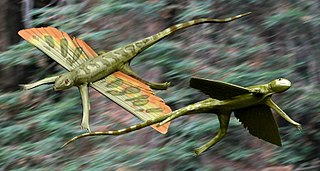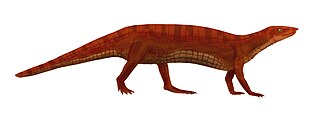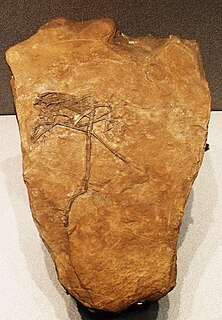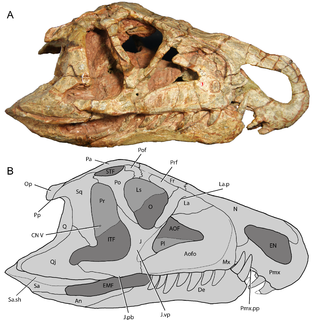 W
WAetosauroides is an extinct genus of aetosaur from the Late Triassic of South America. It is one of four aetosaurs known from South America, the others being Neoaetosauroides, Chilenosuchus and Aetobarbakinoides. Three species have been named: the type species A. scagliai, A. subsulcatus and A. inhamandensis. Fossils have been found in the Cancha de Bochas Member of the Ischigualasto Formation in the Ischigualasto-Villa Unión Basin in northwestern Argentina and the Santa Maria Formation in the Paraná Basin in southeastern Brazil. The strata date to the late Carnian and early Norian stages, making Aetosauroides one of the oldest aetosaurs.
 W
WAgnosphitys is a genus of silesaurid dinosauriform that lived during the Late Triassic. It contains only one species, the type species A. cromhallensis. Its remains include an ilium, maxilla, astragalus and humerus, which date variously from the Norian and Rhaetian stages of the Late Triassic, or possibly as late as the Hettangian stage of the Early Jurassic. The fissure fill at Avon, of which Agnosphitys was probably recovered from, was a sinkhole formed by the dissolution of Lower Carboniferous limestones.
 W
WArganodus is an extinct genus of Ceratodontidae (lungfish). Its fossils have been found in the Redonda Formation, New Mexico, the Tacuarembó Formation of Uruguay, and the Cumnock Formation, North Carolina, although the North Carolinian specimens are smaller than most recorded specimens. Fossils have also been uncovered in the Petrified Forest National Park. It was first named by Martin in 1979, and contains two species, A. dorotheae and A. atlantis. Arganodus was probably similar to modern lungfish, and lived in underwater burrows during dry periods until monsoons occurred.
 W
WAustriadactylus is a genus of "rhamphorhynchoid" pterosaur. The fossil remains were unearthed in Late Triassic rocks of Austria.
 W
WColobops is a genus of reptile from the Late Triassic of Connecticut. Only known from a tiny skull, this reptile has been interpreted to possess skull attachments for very strong jaw muscles. This may have given it a very strong bite, despite its small size. However, under some interpretations of the CT scan data, Colobops's bite force may not have been unusual compared to other reptiles. The generic name, Colobops, is a combination of κολοβός (kolobós), meaning shortened, and ὤψ (ṓps), meaning face. This translation, "shortened face", refers to its short and triangular skull. Colobops is known from a single species, Colobops noviportensis. The specific name, noviportensis, is a latinization of New Haven, the name of both the geological setting of its discovery as well as a nearby large city. The phylogenetic relations of Colobops are controversial. Its skull shares many features with those of the group Rhynchosauria, herbivorous archosauromorphs distantly related to crocodilians and dinosaurs. However, many of these features also resemble the skulls of the group Rhynchocephalia, an ancient order of reptiles including the modern tuatara, Sphenodon. Although rhynchosaurs and rhynchocephalians are not closely related and have many differences in the skeleton as a whole, their skulls are remarkably similar. As Colobops is only known from a skull, it is not certain which one of these groups it belonged to. Pritchard et al. (2018) interpreted it as a basal rhynchosaur, while Scheyer et al. (2020) reinterpreted it as a rhynchocephalian.
 W
WColoradisaurus is a genus of massospondylid sauropodomorph dinosaur. It lived during the Late Triassic period in what is now La Rioja Province, Argentina. It is known from the holotype PVL 5904, nearly complete skull. It was discovered and collected from the upper section of the Los Colorados Formation of the Ischigualasto-Villa Unión Basin.
 W
WEfraasia is a genus of basal sauropodomorph dinosaur. It was a herbivore which lived during the middle Norian stage of the Late Triassic, around 210 million years ago, in what is now Germany. It was named in 1973 after Eberhard Fraas, who during the early twentieth century collected what were the original type specimens.
 W
WEucnemesaurus is a basal sauropodomorph dinosaur genus usually considered to be a synonym of Euskelosaurus. Recent study by Yates (2006), however, indicates that it is valid and the same animal as putative "giant herrerasaurid" Aliwalia.
 W
WEudimorphodon was a pterosaur that was discovered in 1973 by Mario Pandolfi in the town of Cene, Italy and described the same year by Rocco Zambelli. The nearly complete skeleton was retrieved from shale deposited during the Late Triassic, making Eudimorphodon one of the oldest pterosaurs known. It had a wingspan of about 100 centimetres (3.3 ft) and at the end of its long bony tail may have been a diamond-shaped flap like in the later Rhamphorhynchus. If so, the flap may have helped it steer while maneuvering in the air. Eudimorphodon is known from several skeletons, including juvenile specimens.
 W
WFasolasuchus is an extinct genus of rauisuchid. Fossils have been found in the Los Colorados Formation of the Ischigualasto-Villa Unión Basin in northwestern Argentina that date back to the Norian stage of the Late Triassic, making it one of the last rauisuchians to have existed before the order became extinct at the end of the Triassic.
 W
WIsanosaurus was a sauropod dinosaur from Thailand. It was originally dated to approximately 210 million years ago during the Late Triassic, which would make it one of the oldest known sauropods. Its age was later considered uncertain, and may be as young as Late Jurassic. The only species is Isanosaurus attavipachi. Though important for the understanding of sauropod origin and early evolution, Isanosaurus is poorly known. Exact relationships to other early sauropods remain unresolved.
 W
WKuehneosaurus is an extinct genus of Late Triassic kuehneosaurid reptile known from the Late Triassic of Luxembourg. It was named by P. L. Robinson in 1962 and the type and only species is Kuehneosaurus latus. Measuring 72 centimetres long, it had "wings" formed from ribs which jutted out from its body by as much as 14.3 cm, connected by a membrane which allowed it to slow its descent when jumping from trees. It is a member of a family of gliding reptiles, the Kuehneosauridae, within the larger group Lepidosauromorpha, which also contains modern lizards and tuatara.
 W
WKwanasaurus is an extinct genus of silesaurid dinosauromorph reptiles from the Late Triassic of Colorado. It is known from a single species, Kwanasaurus williamparkeri. Kwanasaurus had a deeper, stronger skull and greater specialization for herbivory compared to other silesaurids. It also possessed many unique characteristics of the snout, ilium, and lower part of the femur. It was described along with new specimens of Dromomeron from the Eagle Basin, the northernmost extent of the Chinle Formation.
 W
WLessemsaurus is an extinct genus of sauropod dinosaur belonging to Lessemsauridae.
 W
WMetoposaurus meaning "front lizard" is an extinct genus of stereospondyl temnospondyl amphibian, known from the Late Triassic of Germany, Italy, Poland, and Portugal. This mostly aquatic animal possessed small, weak limbs, sharp teeth, and a large, flat head. This highly flattened creature mainly fed on fish, which it captured with its wide jaws lined with needle-like teeth. Metoposaurus was up to 3 m long and weighed about 450 kg. Many Metoposaurus mass graves have been found, probably from creatures that grouped together in drying pools during drought.
 W
WMussaurus is a genus of herbivorous sauropodomorph dinosaur that lived in southern Argentina during the Late Triassic, about 215 million years ago. It receives its name from the small size of the skeletons of juvenile and infant individuals, which were once the only known specimens of the genus. However, since Mussaurus is now known from adult specimens, the name is something of a misnomer; adults possibly reached 6 metres (20 ft) in length and weighed more than 1,000 kilograms (2,200 lb). Mussaurus possesses anatomical features suggesting a close, possibly transitional evolutionary relationship with true sauropods.
 W
WNeoaetosauroides is an extinct genus of primitive aetosaur. Its type and only species is N. engaeus. Fossils have been found in Los Colorados Formation outcropping along the Sierra Morada River in the Ischigualasto-Villa Unión Basin in La Rioja, Argentina, and date back to the Norian age of the Late Triassic. It was the first aetosaur known from the formation, with remains being discovered in the 1960s.
 W
WPeteinosaurus was a prehistoric genus of pterosaur. It lived in the late Triassic period in the late Norian age, and at a wingspan of around 60 cm (24 in), was one of the smallest and earliest pterosaurs.
 W
WPreondactylus is a genus of long-tailed pterosaurs from the Late Triassic that inhabited what is now Italy. It contains a single known species, Preondactylus buffarinii, which was discovered by Nando Buffarini in 1982 at the Forni Dolostone near Udine in the Preone valley of the Italian Alps.
 W
WProcompsognathus is an extinct genus of coelophysid theropod dinosaur that lived approximately 210 million years ago during the later part of the Triassic Period, in what is now Germany. Procompsognathus was a small-sized, lightly built, ground-dwelling, bipedal carnivore, that could grow up to 1 m (3.3 ft) long.
 W
WPseudhesperosuchus is a genus of sphenosuchian, a type of basal crocodylomorph, the clade that comprises the crocodilians and their closest kin. It is known from a partial skeleton and skull found in rocks of the Late Triassic (Norian-age) Los Colorados Formation of the Ischigualasto-Villa Unión Basin in northwestern Argentina.
 W
WPterospondylus is a dubious genus of theropod dinosaur from the Late Triassic. It was a coelophysoid theropod which lived in what is now Germany. The type species, Pterospondylus trielbae,, was described by Jaekel in 1913-14 for a single back vertebra. Sometimes, it is aligned with Procompsognathus, or even considered to be synonymous with it, despite being based on a vertebra that is twice the size of the corresponding bone in Procompsognathus.
 W
WPtychoceratodus is an extinct genus of prehistoric sarcopterygians or lobe-finned fish originally named as a species of Ceratodus in 1837. It was a lungfish from the Mesozoic era (Triassic-Cretaceous), and the only members of the family Ptychoceratodontidae. One species, P. oldhami, was named in 2018 based on remains from the Carnian-aged Tiki Formation (India). The first named species, which is also the type species, is P. phillipsi, which was named in 1837 by Louis Agassiz as a species of Ceratodus and moved to a separate genus in 1926.
 W
WRhynchosaurs were a group of Triassic diapsid reptiles from the group Archosauromorpha, meaning they were distantly related to the archosaurs.
 W
WRiojasaurus was a herbivorous sauropodomorph dinosaur named after La Rioja Province in Argentina where it was found in the Los Colorados Formation in the Ischigualasto-Villa Unión Basin by José Bonaparte. It lived during the Late Triassic and grew to about 10 metres (33 ft) long. Riojasaurus is the only known riojasaurid to live in South America.
 W
WRiojasuchus is an extinct genus of Late Triassic (Norian) quadrupedal crurotarsan archosaur. Riojasuchus is a member of Ornithosuchidae, a family of facultatively bipedal carnivores that were geographically widespread during the Late Triassic. Two other genera, Ornithosuchus and Venaticosuchus, are currently known. The holotype specimen is PVL 3827. It was found in the Los Colorados Formation of the Ischigualasto-Villa Unión Basin in northwestern Argentina.
 W
WRuehleia is a genus of sauropodomorph dinosaur from the Late Triassic period of Germany. The type species is R. bedheimensis, described by Galton in 2001, and is named for the German paleontologist Hugo Ruehle von Lilienstern. The fossils consist of one nearly complete skeleton, consisting of cervical (neck), dorsal (back), and caudal (tail) vertebrae; a partial sacrum; a scapulocoracoid; pelvic bones; most of the limb bones; and partially complete manus (hands).
 W
WSacisaurus is a silesaurid dinosauriform from the Late Triassic (Norian) Caturrita Formation of southern Brazil. The scientific name, Sacisaurus agudoensis, refers to the city where the species was found, Agudo in the Rio Grande do Sul state, whereas Sacisaurus refers to Saci, a famous one-legged creature from Brazilian mythology, because the fossil skeleton was found with a leg missing.
 W
WZupaysaurus is a genus of early theropod dinosaur living during the Norian stage of the Late Triassic in what is now Argentina. Fossils of the dinosaur were found in the Los Colorados Formation of the Ischigualasto-Villa Unión Basin in northwestern Argentina. Although a full skeleton has not yet been discovered, Zupaysaurus can be considered a bipedal predator, up to 4 metres (13 ft) long. It may have had two parallel crests running the length of its snout.